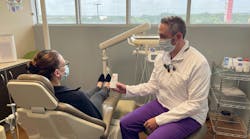Throughout my childhood, I had no restorations in my mouth, apart from pit and fissure sealants. My father and uncle were dentists, as is my brother-in-law. My sister is a hygienist. It makes sense that I would have no caries as a child. I was low caries risk my entire childhood. Of course, it didn’t stay that way when I went to college. I came back after my freshman year at the University of Texas with eight class II lesions. Oops! I did make it 18 years, though. Not bad!
Related reading:
- How would you like your toothpaste: With or without sodium lauryl sulfate?
- Dental sealants and pediatric patients: Options, benefits, and drawbacks
I don't have children myself, but all my friends do, and I am fortunate to treat them. I don't love restorative dentistry on pediatric patients, but I don't mind providing preventive services. When I was a kid, my prophies were short and sweet. Polish, fluoride gel, and done! That doesn't seem to be what happens with my friends’ kids in my hygiene chairs. Their kids have calculus. Their kids have sticky plaque. Most of all, they have all had caries on primary teeth, and I have had to perform restorations on them.
This isn't fun for them, for their parents, or for me. While we may think of childhood caries as a disease affecting only those of low socioeconomic status, it is certainly not. An increase in sugary drinks, fruit snacks, and gummy vitamins seem to be but a few factors in raising caries risk for children across the board. I do not find restorative dentistry on pediatric patients to be extremely fun or profitable, so I went looking for answers to reduce the caries risk in my friends’ kids and other pediatric patients. I found an answer in an old friend … PreviDent 5000 ppm dentifrice.
I have been a PreviDent Booster 5000 ppm user for years. Since my freshman year of college, I have been using PreviDent in some form or another. However, we often think of prescription 5000 ppm dentifrice as an adult option. We sometimes hesitate to use fluoride in kids because we worry about ingestion. Plus, that strong minty flavor is not exactly a kid’s favorite. Colgate has answered these questions with PreviDent 5000 Kids. The Fruitilicious flavor is a favorite for kids. When they use a thin ribbon on their brush and expectorate after, it is completely safe. This is a great product to use for your pediatric patients with high caries risk.
At the end of the day, a dental practice is a business, though. Can prevention in pediatric and adult patients be profitable? Let’s look at some data to find out. Thankfully, Sikka Software Corporation has done some research supported by Colgate,1 and the results will surprise you.
Sikka is a data analytics company focusing on retail health care. They took on the challenge of answering the great question of preventive dentistry: Does fluoride use (in this case, PreviDent 5000) actually benefit the patient?
Fluoride study specifics
The first step to answering this question was setting up a patient selection method. For a study like this, we want to examine a lot of average patients to get an idea of their disease patterns. We know from other Sikka analytics studies that the typical patient receives 10 procedures over a two-year period in a dental office. Patients who were prescribed PreviDent 5000 and have had at least 10 procedures before and after the prescription was written were selected to participate in the study.
A total of 1,200 patients who matched these qualifications were chosen at random from dental practices all over the country. Of them, 300 were Millennials (28–43 years old), 300 were Generation Xers (44–59 years old), 300 were Baby Boomers (60–72 years old), and finally 300 were members of the Silent Generation (73-plus years old). When procedural and cost data from these patients were examined, Sikka found an absolute advantage for patients who had been prescribed PreviDent 5000. I am guessing that this data would hold true on children as well.
Study results
In general, the patients who were prescribed PreviDent 5000 spent less money on dentistry than patients who were not prescribed PreviDent. Sikka investigated further to see where those savings came from. The category that patients saved on most was, by far, restorative dentistry. Patients who were prescribed PreviDent 5000 spent, on average, 48% less on restorative dentistry. That adds up to an average total savings of $1,176 per patient on restorative dentistry. This figure represents a 16% savings on endodontic procedures, 11% savings on periodontal procedures, and an 11% savings on oral and maxillofacial surgery procedures. Those numbers are significant and staggering! This study shows us that we can help our patients spend less on dentistry by prescribing PreviDent 5000. As dentists, we are probably the only business owners who would look at this as good news. If your favorite spa could give you a prescription that would decrease the amount of money you spent at the spa, would they do it? The answer, most likely, is no.
But dentistry is different. We are taught the value of preventive dentistry in dental school. As professionals who want the best for our patients, having them spend less on restorative dentistry is a good thing, especially for children whose habits and experiences can affect the rest of their lives. But how does this work from a business owner’s perspective? Is it advantageous for us to prescribe PreviDent 5000? I would say yes, and Sikka’s data backs me up.
Ramifications in practice
I am a restorative dentist. I love performing restorative dentistry. However, I do not love performing caries-control procedures on high caries risk pediatric patients. Those appointments can be stressful, grueling, and painful for both the patient, my back and neck, and both of our emotions and mental health. I would much rather use my time to do comprehensive esthetic and restorative dentistry such as smile makeovers, veneers, full-mouth rehabilitation, and clear aligners on adults. Those procedures keep me stimulated and excited much more than a quadrant of class IIs on a kid or teen with high caries risk.
The study looked at the referral habits of patients who were prescribed PreviDent 5000 versus those who were not. It turns out that, generally, patients who were prescribed PreviDent referred more friends, family, and loved ones than those who were not. To me, that speaks to the increase in patient satisfaction that comes with a prevention-first approach. Those patients are just happier. They are not hit as often by the revolving door of re-restoration. They have more happy visits with less bad news and expensive treatment plans. Those happy patients pay it forward by referring about 20% more.
The study didn’t just stop at patient referrals when examining the success of practices that prescribe PreviDent 5000. They utilized their proprietary Sikka Score,2 which is based on 10 different key performance indicators, to differentiate between the two groups of practices. On average, practices that prescribe PreviDent 5000 have higher Sikka Scores than those that do not. Prescribing PreviDent 5000 can lead to a more successful practice. It may do this by increasing patient satisfaction and experience. That type of increase is invaluable and can help offset losses in high caries risk dental procedures.
A win-win-win
If you read my “Pearls for Your Practice” column in Dental Economics, you know that I am an avid baseball fan. One of my favorite baseball books is Moneyball. Moneyball taught me an entirely new way to look at the game based on analytics. Sikka has done the same with its study. My personal experience has told me that PreviDent 5000 is a winner. Now, with this broad-reaching data, I know that prescribing PreviDent 5000 Kids is a winner. It is a winner for my pediatric patients because it saves them from pain, suffering, and stress. It is a winner for their parents because it saves them money and stress. It is a winner for me because it makes my patients happier and my practice more successful. Prescribing PreviDent 5000 Kids is a grand slam!
Editor's note: This article appeared in the January/February 2024 print edition of RDH magazine. Dental hygienists in North America are eligible for a complimentary print subscription. Sign up here.
References
- Colgate PreviDent 5000 Study. Internal study. Sikka Software Corporation. 2020.
- Success dashboard. Internal study. Sikka Software Corporation. 2020.
Joshua Austin, DDS, MAGD, is a graduate and former faculty member of the University of Texas Health Science Center at San Antonio School of Dentistry. Author of Dental Economics’ Pearls for Your Practice column, Dr. Austin lectures nationally on products, dental technology, online reputation management, and social media. He maintains a full-time restorative dentistry private practice in San Antonio, Texas. You may contact Dr. Austin at [email protected].







